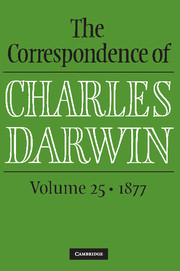Introduction
Published online by Cambridge University Press: 26 October 2017
Summary
Ever since the publication of Expression of the emotions, Darwin's research had centred firmly on botany. The year 1877 was no exception. The spring and early summer were spent completing Forms of flowers, his fifth book on a botanical topic. He then turned to the mysterious role of the waxy coating (or ‘bloom’) on leaves and fruit, and to the movement of plants, focusing especially on the response of leaves to changing conditions. He also worked intermittently on earthworms, for the most part gathering observations made by others. With the exception of bloom, each of these projects would culminate in a major publication. Darwin's botany was increasingly a collaborative affair with his son Francis, who had moved back to Down House after the death of his wife, Amy, the previous year. He assisted his father's research on movement and bloom, and Darwin in turn encouraged his son's own work on plant sensitivity and digestion. William, who had contributed to some of the early research on heterostyly, provided further observations on this, as well as on bloom. He most pleased his father, however, by his engagement to Sara Sedgwick, an American from a family that the Darwins had befriended.
The year 1877 was more than usually full of honours. Darwin received two elaborate photograph albums for his birthday in February. These lavish gifts had been many months in preparation, and involved hundreds of contributors from Germany, Austria, and the Netherlands. Closer to home, Darwin received an honorary Doctorate of Laws from Cambridge University. He returned to his alma mater in November to hear a Latin oration composed specially for the occasion. He avoided dinner parties and used his spare time to scout sites for possible earthworm activity. Now in his 69th year, Darwin remained remarkably productive, and was happiest when at work on topics requiring careful observation and experiment, and little or no controversy.
In his autobiographical reflections, Darwin remarked: ‘no little discovery of mine ever gave me so much pleasure as the making out the meaning of heterostyled flowers’ (‘Recollections’, p. 419). During the winter and spring, Darwin was busy preparing the manuscript of Forms of flowers, an expansion and reworking of five papers on sexual dimorphism and trimorphism that he had written between 1861 and 1868 and presented to the Linnean Society of London.
Information
- Type
- Chapter
- Information
- The Correspondence of Charles Darwin , pp. xvii - xxviiiPublisher: Cambridge University PressPrint publication year: 2017
